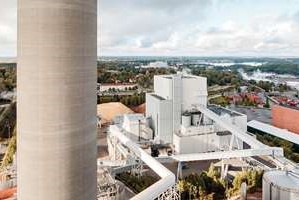 Powering the world from pulp
Powering the world from pulp
A new study claims that CO2 from pulp mills could be used to create enough synthetic fuels to power an entire country.Modern pulp mills are super-efficient. They create more power than they need and use every bit of wood they receive. Yet pulp mills do have a side stream which has been underutilised: bio-based carbon dioxide. A new study has shown that carbon emissions from pulp mills can be captured and transformed into a massive quantity of synthetic fuels.
The idea is to scrub carbon dioxide from pulp mill exhaust and combine it with hydrogen to create synthetic petrol, kerosine or diesel. These synthetic fuels could replace fossil fuels currently used in ships, planes, trucks and cars.
Finland has one of the most ambitious goals in the world: to be carbon neutral by 2035. Researchers at the Lappeenranta University of Technology (LUT), the energy company St1 and the marine and energy company Wärtsilä studied how Finland could use CO2 side streams to produce carbon-neutral liquid fuels in order to achieve their goal of carbon neutrality.
“We found that ten of the biggest bio-based sources of CO2 in Finland could provide about double the amount of liquid fuel we need. Instead of importing 5 billion euros worth of fuel annually, Finland could be exporting that much,” says Petteri Laaksonen, Research Director at LUT’s School of Energy Systems and one of the lead authors of the study.
Wanted: lots more wind power
The researchers looked at the largest mills in Finland, including UPM’s Kaukas, Kymi and Pietarsaari plants. These mills release CO2 which had been in the wood raw material, but the idea is to capture and reuse it.
“Fossil-based CO2 has a monetary cost, if you consider the EU Emissions Trading Scheme (ETS). But CO2 can also have a value,” says Laaksonen.
Biogenic CO2, which is emitted from pulp mills, is part of the biomass-based carbon circle where growing forests sequester CO2 from the atmosphere. This circle is generally considered neutral to the environment and so is not part of the ETS. Turning biogenic CO2 from pulp mills into synthetic fuels would tighten the loop even more.
Hydrogen is needed to create synthetic fuels, but that element is abundant in H2O, or water. Electrolysis uses electricity to split water into hydrogen and oxygen. The challenge is the process needs a lot of electricity. Finland would need to increase electricity production by 270 per cent, according to one of the scenarios in the study.
“This electricity could come from wind power,” Laaksonen continues. “In the world’s sun belt electricity produced from solar power is the cheapest. But in the far north and south of the world wind power can be the most efficient.”
Making economic sense
“The technology to capture carbon dioxide, produce hydrogen from electrolysis and combine them to create synthetic fuels already exists, although some of the technology might not be mature yet,” says Jyrki Ovaska, Executive Vice President, Technology, UPM. “The real hurdles are the market price of energy and the existing regulatory framework.”
To create a massive amount of hydrogen requires a massive amount of energy. If the electricity can be produced cheaply enough, the scenario of creating synthetic fuel begins to make economic sense. Also, energy, fuel and emissions are highly regulated, and these regulations need to be updated.
“UPM wasn’t part of this particular study, but we work closely with universities including LUT,” Ovaska continues. “We are already developing biochemicals and biofuels, as well as other circular economy processes, so it isn’t a big leap to think about synthetic fuels.”
Meeting Paris Agreement goals
One of the biggest benefits of the idea is that it captures and reuses CO2 which otherwise would One of the biggest benefits of the idea is that it captures and reuses CO2 which otherwise would have been released. In January 2020 UPM set a target to reduce emissions by 65% from 2015 levels by 2030. This aligns with the Paris Agreement to limit global warming to 1.5 degrees.
Already, UPM is taking action to lower CO2 emissions from operations, including pulp mills. This is happening through a variety of measures, such as constantly improving efficiency so less fuel is used. The target is to improve energy efficiency by 1% every year. Another way is to use different types of energy sourcing, such as UPM’s long-term deal to use wind power for paper mills which will reduce CO2 emissions by 200,000 tonnes annually as of 2022.
“We have an opportunity to be carbon positive, not just in our operations but also if you think of substituting fossil-based products with our wood-based products,” Ovaska says. “We will be looking at producing synthetic fuels from pulp mill emissions very closely. There are still many questions to be answered, but if all those boxes can be checked we could be the first company to do this.”
